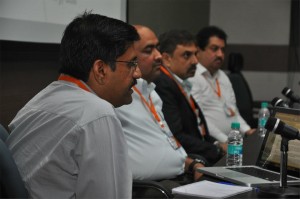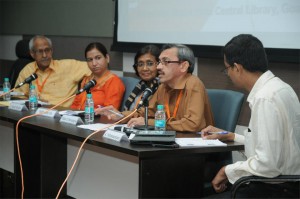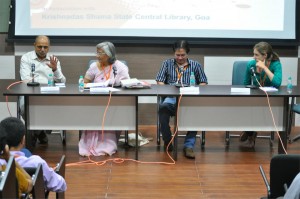A report on three critical discussions from Publishing Next
by Vinutha Mallya
For those of us that have freshly emerged from the stimulating Publishing Next conference in Goa on 14–15 September, it will be a while before we can completely absorb all that was discussed over the intense two days.
Venkatesh Krishnamoorthy’s reports from the conference have presented many of the highlights, so readers would be aware of the event by now.
That the publishing industry in India is undergoing not merely a transformation, but a tectonic shift, would be obvious by now.
While news of new publishing software technologies emerging in the West makes us aspire to catch up and “redefine” everything, any publisher who’s been in the business long enough knows that in India we operate in three centuries simultaneously. Hence, there is no single way, no one formula, no one answer: pretty much mirroring the diversity that our nation is known for. The sooner we accept this, our task to provide viable models and solutions would become less overwhelming. We could truly innovate, instead of imitating.
Three panel discussions at the conference were based on areas where a bulk of India’s publishing (and its ‘readers’) is situated.
Academic Publishing
Book publishing in India is often viewed from two different prisms: the more glamorized trade segment of literary fiction and non-fiction, and the academic segment comprising of books for schools and higher education. The share of academic publishing in the industry pie is far bigger than other segments, a fact not often acknowledged.

The panelists discussing academic publishing in India, mostly representing the big academic (multinational!) publishers, outlined their company’s publishing programme, highlighting their early adaption to digital and online publishing technologies.
In the case of Springer, a major STM (Scientific, Technical and Medical) publisher of books and research journals, the books are DRM free. Their motto is “e-first” said Sanjiv Goswami, MD of Springer India.
Pearson, which defines itself as an “education” and not a “publishing” company, has observed that this business is moving. The shift is from individualistic decisions of purchase to institutional purchase trends, according to K. Srinivas, Publisher of Pearson Education in India.
Vivek Mehra, MD and CEO of SAGE India pointed out: India offers the bulk of services for publishers worldwide, most of it in the STM segment. In the last 15 years, the outsourcing of publishing services to India has generated 5 times more employment than direct publishing activities, he said.
Panelist Manoj Karthikeyan of Veda Publishing Consultancy addressed an unspoken topic among publishing forums: the problems and perceptions of “Indian content”. Content generated in India carries the tag “of not good quality” because many Indian publishers cut corners and don’t check for plagiarized material. He concluded by reminding us that we needed to set our house in order before we complained that Indian content has not got its due.
Opportunities in Language Publishing
Although clubbed as a uniform category, Indian-language publishing is actually many different industries, each with its own character, and its own unique set of problems and challenges. This was apparent in the presentations made by panelists that covered these language industries—Konkani (Goa’s state language), Marathi, Bangla, Tamil and Hindi.
Writers in Goa are not very demanding of royalties, said eminent Konkani writer Damodar Mauzo. They are more concerned that Konkani language and culture should receive due recognition. But book sales are hindered by the fact that marketing efforts and production quality are lacking in Goa. Konkani, as a language that is spoken in 5 states and written in 5 scripts—Devnagari (official), Romi (Roman), Kannada, Malayalam and Perso-Arabic—lends itself to audio books, since they would overcome the hurdle of multiple scripts, Mauzo added.
Based in Bhopal, Ekalavya is known for pioneering efforts in education at the grassroots level. Deepali Shukla presented the publication programme of the organization, which publishes books in Hindi and other languages. She touched upon the unfair trade practices in book procurement (this topic is a Pandora’s box if and when opened) at state-government level, which is the main agency for dissemination of children’s books in public schools.

A rich literary tradition drives the Bangla publishing industry to this day (“Almost every Bengali writes poetry”!). There are about 600 publishers and almost the same number of booksellers in Paschimbanga (West Bengal), said Subhadra De, from Chhatim Books. Even small publishers produce very good books. The Bangla book market is price sensitive. The publishers have to deal with the problem of piracy of their books in Bangladesh. Once known for its high density of libraries, Paschimbanga is now witnessing private libraries shut down, but its government libraries are still strong.
Books translated into Marathi from other languages are getting good response from readers, said Vikas Paranjape, Partner at Jyotsna Prakashan. Marathi authors expect royalty and even litigate if denied their due (in stark contrast to the writers of neighbouring Goa!). Piracy has emerged as a major issue in Marathi publishing. The Marathi book market is not price sensitive, especially for fiction. The good news is that the readership base is widening, with more readers reading books in Marathi. The NRI market is yet untapped, he added. Interestingly, poetry, a genre that many publishers in rest of India find difficult to sell, does well in Maharashtra, just as it does in Paschimbanga, and perhaps a handful of other language industries. About 8000 to 9000 libraries exist across Maharashtra, but not all are well equipped.
Paranjape spoke of an interesting venture—eMarathi.com—an e-book platform formed by a consortium of 6 major Marathi publishers, who have invested in it and through which they will sell e-books soon.
Family-controlled businesses, which continue to maintain a conservative approach; the lack of professionalism; and a lack of trained professionals, are the main hindrances to growth of publishing industry in Maharashtra, according to Paranjape said. (One could say that this is also true for the rest of the country, although the new generation is adopting new-economy models in their family businesses. So, changes are imminent, one hopes.)
Down south, Tamil publishing industry is strong. It consists of about 500 odd publishers, with about 100 publishers producing reasonably good quality books, said K. Satyanarayan, co-founder of New Horizon Media. There are about 4000 public libraries across the state of Tamil Nadu. All literary genres do well in the state. Books in translation are not very common, but publishers like NHM and Kalachuvadu Publications have an active translations list. (Additionally, the Tamil diaspora around the world, in countries like Sri Lanka, UK, Canada, France, Australia, Malaysia and Singapore, consume books published in Tamil Nadu.)
One common roadblock that all publishers face is the absence of a distribution system for their books. The publishers have to manage their own distribution.
In the absence of such channels and due to insufficient bookstores, in Maharashtra, for example, privately organized book fairs are held throughout the year, which ensures steady sales. (The annual Kolkata and Chennai book fairs are where many Bangla and Tamil publishers do a bulk of their annual sales.)
More and more, Indian-language publishers and book-buyers are depending on online booksellers like Flipkart, which has given a significant boost to the sale of Indian-language books. “Everyone, from publisher to reader, is happy with Flipkart’s service,” said Paranjape.
Preservation of Oral Traditions
The closing panel discussion of the conference was on the interesting theme of oral traditions, another topic almost never discussed by publishers at any industry forum. Preceding this panel discussion was an insightful talk by Prof. Ganesh Devy, a world-renowned scholar, linguist and activist for preservation of languages. He said that many languages around the world have come to a stage of great crisis. While only some Indian languages are printed (and therefore, published), several hundreds remain in the oral realm, but which are not recognized as “official language” by the administration simply because they are not printed. Prof. Devy urged publishers to invest in languages because “books are memory manifest”.
His People’s Linguistic Survey of India has set out to document the living languages in India, and his institute based in Vadodara—Bhasha Research and Publishing Centre—has worked with 65 adivasi communities to develop scripts for their languages.

The panel discussion, moderated by Venetia Kotamraju, founder of Rasãla Books, began with her asking if the recording of oral traditions is always a good thing. The memorizing (of community knowledge) gets affected, and often one version becomes “authentic”.
The neglect of India’s vast treasury of folk tales is disturbing to Nilima Sinha, author and President of AWIC/India IBBY, who rued that today’s heroes are not from our epics anymore. Instead, children are becoming obsessed with characters like Harry Potter. She demonstrated how oral storytelling communicates a story more richly than reading the same in print, by narrating a lyrical story in Bhojpuri.
Dr Desmond Kharmawphlang, a noted folklorist and poet based in Shillong who has done extensive work in documenting folklore in north-east India, shared his insights. He spoke of how each state in the region has at least 20 languages (more in some), which are weakened by the imposition of an “official language”, which is usually the language of the dominant tribe or community in the state.
This panel introduced another side to the publishers’ community, with refreshing viewpoints and food for thought.
The three panels reported above engaged the participants in the Q&A sessions, and revealed that these areas need more discussion. One hopes that succeeding industry gatherings will take these issues further, because the more we discuss them, the better the solutions that will emerge.
This article first appeared on yourstory.in
Vinutha Mallya is an independent publishing consultant, editor and journalist. She is an advisor to the Publishing Next conference. Follow her on Twitter @VinuthaMallya.